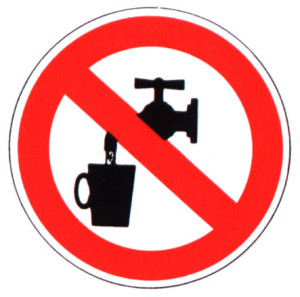More good news about contamination from your friends at Rocketdyne
By Michael Collins
Los Angeles CityBeat/ValleyBeat – September 27, 2004

With new revelations coming almost monthly, the scope of the toxic mess at the Rocketdyne aerospace complex in the hills between the San Fernando and Simi valleys continues to grow. Radiological and chemical pollution at the vast Santa Susana Field Laboratory (SSFL) has been known about for years, but new data suggests that the lethal waste at the site may be continuing to spread. Despite intense media coverage, and pressure from an alarmed community that continues to demand answers, the dribs and drabs of data regarding the 2,668-acre site, in eastern Ventura County, are creating more questions than answers.
On September 9, the Department of Energy (DOE) and Boeing, Rocketdyne’s parent company, held a community meeting in Simi Valley to discuss new findings of radioactive tritium in the lab’s groundwater. DOE is supervising a $258 million cleanup of Area IV, the 290-acre part of SSFL where nuclear research was performed since the 1950s. The federal agency directed Rocketdyne to drill more wells to more accurately characterize the extent of the tritium plume under the lab after Boeing revealed in June that the poisonous radionuclide had been found in subsurface water at 80,000 picocuries per liter, four times the national drinking water limit.
At the meeting last week, Rocketdyne divulged that two new wells had high levels of tritium registering approximately 82,000 and 15,400 picocuries per liter near two former Systems for Nuclear Auxiliary Power (SNAP) reactors which were designed for use in space. The SNAP 8 Experimental Reactor Facility suffered a major accident in 1964 in which 80% of its nuclear fuel rods cracked and released radiation from the unconfined building. An adjacent SNAP 8 Development Reactor suffered a similar fate in 1969 with about a third of its fuel also cracking. Tritium readings near the most infamous site of a Rocketdyne nuclear accident, the Sodium Reactor Experiment that experienced a partial meltdown in 1959, registered only background levels of the radionuclide.
“These guys just can’t seem to get it right,” says longtime Rocketdyne critic Dan Hirsch, president of the Los Angeles-based Committee to Bridge the Gap environmental group. “The nuclear facility appears to have been run by the Keystone Cops. It’s hard to conceive of having one nuclear accident, let alone three. They seem to have run their reactors with an extraordinary disregard for public safety.”
Tritium has a half-life of 12.3 years, meaning that the substance decreases in mass by 50% during that period due to ionization. Extrapolating from the current amount of tritium found in SSFL groundwater, Boeing officials estimated that the original amount of the toxin was around 1.2 million picocuries per liter back in the early to mid 1960s – 60 times the maximum amount considered safe for consuming tritium-tainted water.
In 1964, Rocketdyne began to provide workers with bottled water because employees complained of a foul taste and color of the onsite well water that they drank. It is unclear how many workers continued to drink groundwater at SSFL after that since exclusive use of imported water for drinking began in the late 70s, according to Steve Lafflam, Rocketdyne Division Director for Safety, Health and Environmental Affairs. “Maybe some employees drank it, who knows,” Lafflam said in response to a reporter’s questions at the DOE/Boeing community meeting. “It’s the way it is. It’s the way we did it in the `60s.”
Rocketdyne officials stressed that the radioactive groundwater plume has not migrated offsite, yet in1991 it was detected at 5,400 picocuries per liter at Brandeis-Bardin, a Jewish educational and camping facility on SSFL’s northern border. The institute sued Rocketdyne over the pollution and, in 1997, agreed to a confidential settlement with the aerospace giant that included Rocketdyne buying some of the facility’s land that now serves as a buffer zone in the hills above the Simi Valley-based establishment.
More uncertainty about radioactive groundwater possibly emanating from Rocketdyne surfaced recently with the release of a July 20 letter from the California Department of Health Services. Included with the letter was a report by the department’s Radiologic Health Branch (RHB) on testing for radionuclides in seven wells on the adjacent Ahmanson Ranch property conducted in June 2003. The California Sanitation and Radiation Laboratory analyzed RHB well samples for radiation and found some evidence of elevated alpha ionization levels. The amounts of alpha radiation emitted by naturally-occurring alpha radium and uranium were identified, but their emission levels were far less than the total alpha radiation recorded. If this additional and unanalyzed radiation was man-made, its most likely source would be Rocketdyne. Nevertheless, the RHB document states “(T)he DHS/RHB investigation did not confirm the migration of radioactive material in groundwater from the SSFL site to the sampled Ahmanson Ranch groundwater.”
This is small comfort to Ventura County Supervisor Linda Parks, in whose district lays Ahmanson Ranch. “It’s very important that proposals to drain the water out from under Ahmanson Ranch are stopped because any kind of removal of the groundwater could potentially bring in water from neighboring Rocketdyne,” says Parks.
27 Years of Award-Winning SSFL/Rocketdyne Reporting
1998 – 2025












Recent Comments